Stock Market Review March 2009 To August 2011
Bill Murphy and Chris Powell are busy with GATA's much anticipated London Conference this week. I hope both have a good time promoting "Planet GATA" in the belly-of-the-beast. Bill said he was going to omit some of his daily Midas Commentaries while there, as he should if he is to talk to the attendees at the conference. The personal touch is very important when promoting a point of view. They have the touch alright! Since 1999, Bill and Chris have taken GATA a long way since their first notice in the media, where they were long ago described as "two guys with a fax machine." I think it's safe to assume that neither of them felt the need to take the fax machine to London this week. As I had other commitments, I stayed home. But I thought in Bill's absence, I'd write an extra article this week to keep things humming at the Café.
I haven't done much with the Dow Jones Total Market Group Indexes for a few months, so let's take a look at them, with other key indexes often mentioned in the financial media. The data for the following tables are based on weekly closing prices. The BIG TABLE (second table) uses data from Barron's 09 March 2009 & its latest issue 01August 2011. These two issues provide the performance of these indexes from the perspective of credit crisis lows of the Dow Jones, to the end of last week. Everything but CPI (Consumer Price Index) is up by double digits since March 2009.
But not everything bottomed in March 2009. Precious metals and their miners bottomed in late October 2008; five months before the credit crisis low for the Dow Jones. So I created a second table (actually the first in the article) to list these details. Little commented on today, or then, but from its October 2008 lows, the XAU was up by 69% as the Dow Jones hit its bottom in March 2009.
The far right column in the table lists the percentage changes from October 2008 to the latest issue of Barron's. To be fair to the performance of the precious metals from their credit crisis lows in October 2008 (not the Dow's in March 2009), the gains seen in the far right column should be used to accurately describe their post credit crisis gains, not those seen in my second table.
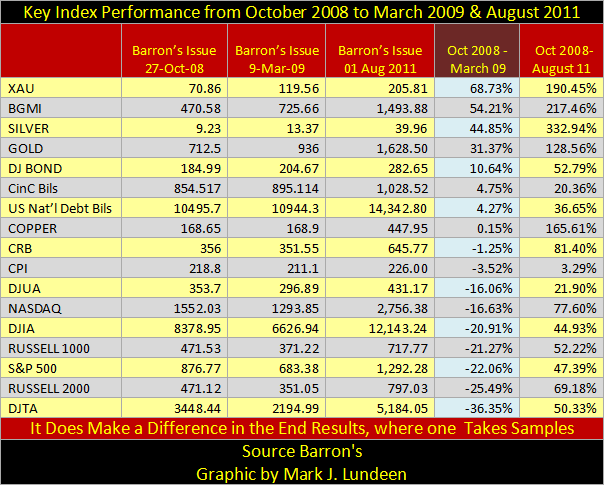
The same can be said for all the other indexes seen in the big table below, as we can see in the Dow Jones Total Market Indexes 52Wk Highs - Lows Ratio chart. This data is for 84 groups in the DJTMG I track.
My list is a bit different from what is actually published in Barron's. Over the last two decades, as Dow Jones updates this series with changes, I may, or more likely don't follow their lead. When they change the names of an Index, I keep the old name as I'm getting cantankerous in my old age.
Be-that-as-it-may, it was in October 2008, when the precious metals hit their credit crisis lows that the 52Wk H-L ratio hit its bottom. When the Dow Jones finally hits its low of 09 March, 15 indexes in the DJTMG had already turned around. Don't ask me which, as in August 2011 we should be noting how the 52Wk highs are now being canceled out by the 52Wk lows. The important market story of August 2011 is one of "liquidity" draining away from the stock and bond markets, and flooding into consumer prices and precious metals.
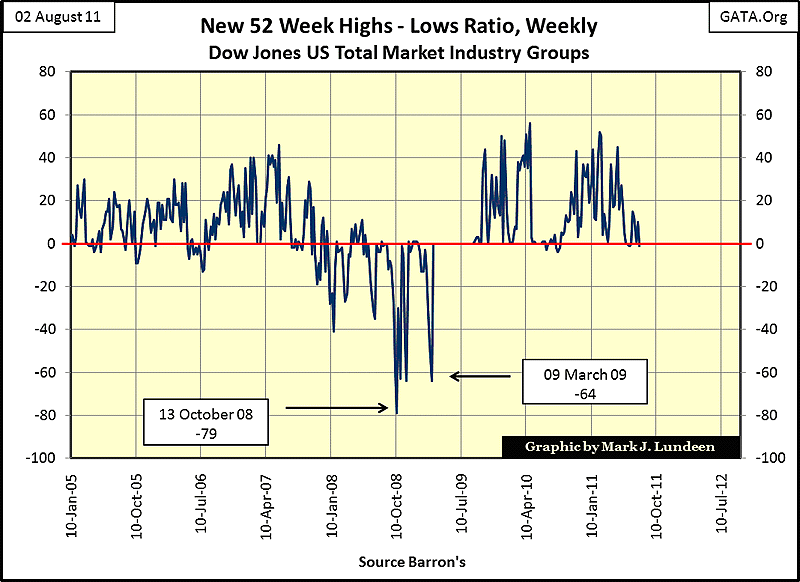
The point of all this is to make clear that performance tables, such as seen in this article, are just snap-shots of the market. The stock market is a dynamic machine, driven by "liquidity" flowing from the Federal Reserve. Every week, the different indexes are jockeying for position, with some indexes inflating in value, while others move down as they deflate. The exceptions are the indexes coming from the Federal Government, which over the longer term, never goes down.
The only government index Washington makes an effort to "contain" is CPI (Consumer Price Inflation). But let's face it, as "consumer" expenses increase at grocery and retail stores, Washington's CPI largely ignores these gains. This is by design. My military pension is indexed to CPI, and it's up only 14% since 2002. A few decades ago I retired as a Navy Chief (E-7 for you USA & USAF guys out there). Between Doctors Greenspan & Bernanke with their inflation, as well as the compulsive binge spending of a host of Presidents, Speakers of the House and Senate Majority Leaders, I'm sure my pay got busted down to Second-Class Petty Officer's (E5) while keeping my "good conduct" in good order. I doubt people living off Social Security are doing any better. Inflation is licensed theft by the government, and the manufactured CPI index is Washington's burglar tool into an aging population's retirement funds.
But at least we on the government's retirement list get an annual Cost of Living Allowance (COLA), pathetic as it may be. However the inflationary losses to the principle of US Treasury Bond holders are unmitigated. It is no mistake that the last time the US Department of Labor reported double-digit gains in their CPI, US Treasury bonds were yielding double-digit too! Today, a bit of honesty with the CPI could collapse the global bond market.
It's actually humorous how seriously CNBC reports CPI each month, they treat it as if it was something important. With baited breadth, the latest CPI figure is read aloud with instant analysis of the market's reaction following. I bitch about CNBC all the time, but actually I love those guys, and very attractive gals. Well, if anyone managing a few billion dollars wants to believe what they hear on TV, that's fine with me. But when 2014 come around, it will become quite evident that the dumbest money in 2011, was is in the bond market.
With all that said, here is how everything has done since March 2009. The gains off the March 2009 bottom have been superb!
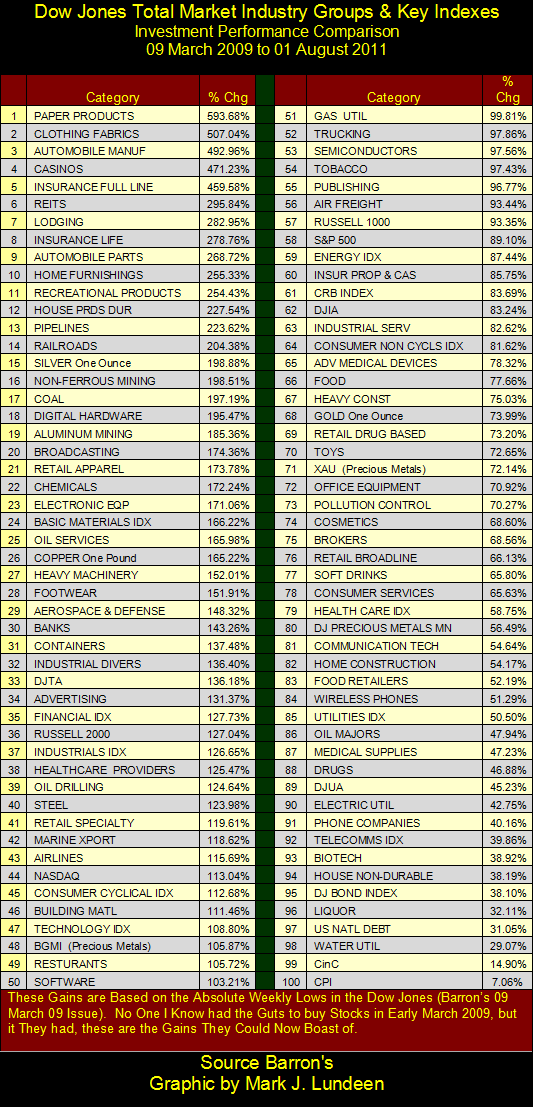
But who bought stocks in March 2009? Someone must have, but I sure didn't have the guts to buy at the bottom! So don't feel bad if your portfolio went up something less than 100% in the past 28 months. In fact, if you're up by only 50%, you may want to take your profits sometime soon, unless your money is in a precious metal investment. I say that because these gains aren't real. Heck, over the "long term" (decades going back to the 1930s), the stock market is only good for something less than 10% a year on average, with lots of really bad years spaced in between the good years. What we are looking at above is the end product of a twenty-eight month program of massive inflation flooding the financial markets. Doctor Bernanke has admitted as much:
"Policies have contributed to a stronger stock market just as they did in March 2009, when we did the last iteration of this. The S&P 500 is up 20% plus and the Russell 2000, which is about small cap stocks, is up 30% plus." -- Doctor Benjamin Bernanke, CNBC Interview with Steve Liesman 13 Jan 2011 (1:40 PM)
There is that word "policy" again, meaning that little in the above table is for real. And when we consider that at no time since March 2009, has "economic growth" as measured in GDP "policy makers" exceeded 6%, how are these indexes' valuation increases to be supported by actual economic activity? And GDP is measured in Doctor Bernanke's dollars. So what if GDP goes up 10%? Does that mean that the economy manufactured, and sold 10% more than the year before, or did end user prices go up 10%? Our current high levels of unemployment strongly suggest that the latter case is the truth. This means that the chart below, showing GDP from 1993, is dubious data at best. These post credit crisis double, and triple digit gains in the stock market seems vulnerable to me.
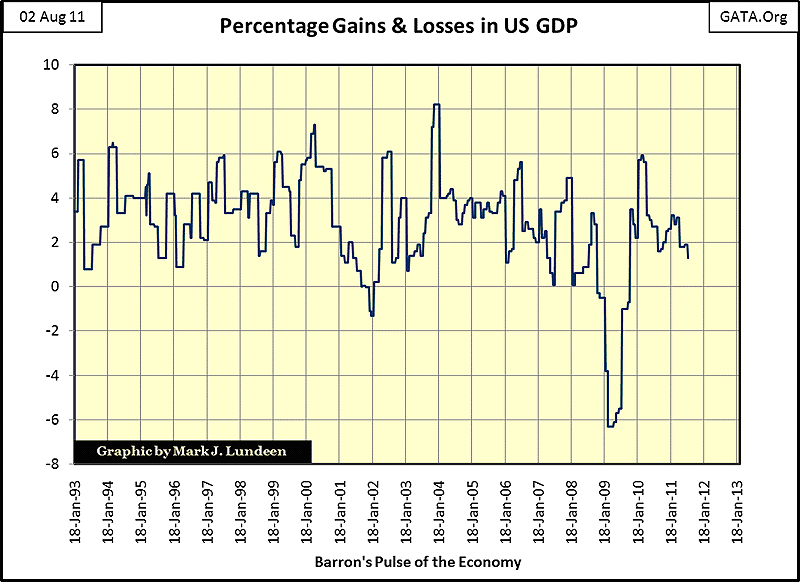
Let's take a look at #5 on the list, Full-Line Insurance Companies. A hot group, especially when we consider how poorly the NYSE Financial Index has done since March 2009. But in truth, the full-line insurance companies don't look so good either. The amazing gains all occurred in the first six months after the lows of March 2009, with little follow through, exactly like the NYSE Financial Index. Even after their 460% dead-cat bounce, this index is still 96% below its highs of 2000. At their lows of March 2009, this index was down 99.25% from its highs, so even after a 460% bounce off its lows, this index is still a total wipeout, gaining only 3% of its pre-credit crisis valuation.
When we remember that during the credit crisis, Doctor Bernanke extended $16 trillion dollars in credit to the major banks of North America and Europe. We should ponder what would have happened to the NYSE Financial Index had he done the right thing and let these big banks fail three years ago. He sure didn't save them! He only delayed their AIG moment, which we see below. And CNBC continues to present "experts" recommending J.P. Morgan and Goldman, who like so many other huge financial companies, have the same humongous-toxic-derivative problem that caused AIG to crash in 2008-9, as we see below!
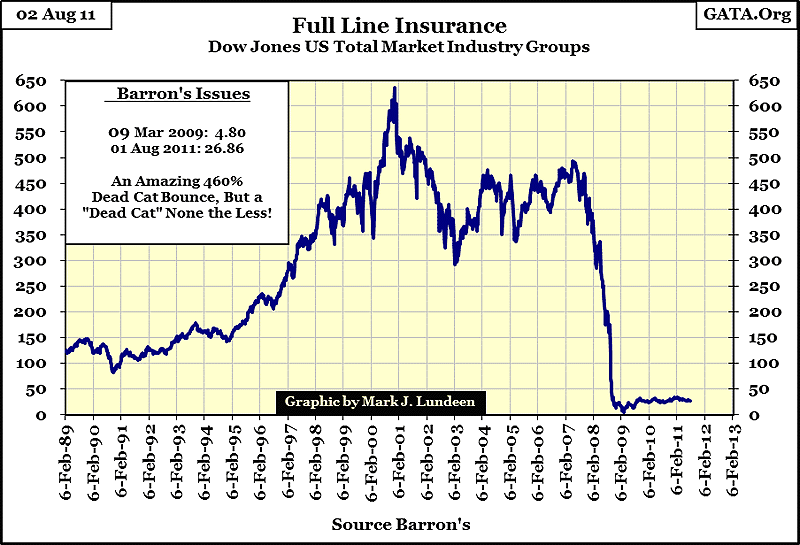
What can I say, I'm a BEAR when it comes to the stock market, and a real GRIZZLY BEAR when it comes to financial companies. If you want happy news on the American financial system - go watch Mandy on CNBC. But, from what I'm looking at every week, hard numbers, not firm bosoms, I expect many of the indexes in the Dow Jones Total Market Group to have their AIG moments before Mr Bear is satisfied with the market's valuation. If the "policy makers" begin their third round of "quantitative easing" (under a brand new name this time) while the Dow Jones is still above 10,000, you'll know I'm not the only one thinking this. The thought of the Dow Jones with a 9000 handle must frighten the "policy makers." If the Dow starts to deflate, no one knows where the basement is. This bear market isn't over just yet; we may yet see the Dow Jones take out the percentage losses it saw in July 1932: -89.19%.
What can people do to protect themselves from what is coming? Just shift your investments into gold and silver coins while they are still cheap!
[email protected]
















